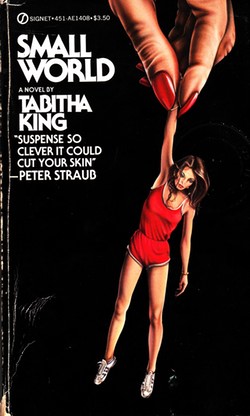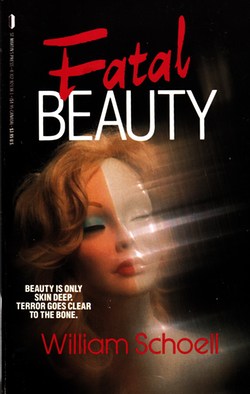Grady Hendrix, author of Horrorstör, and Will Errickson of Too Much Horror Fiction are digging deep inside the Jack o’Lantern of Literature to discover the best (and worst) horror paperbacks. Are you strong enough to read THE BLOODY BOOKS OF HALLOWEEN???
During the horror boom of the 70s and 80s the aesthetic was fast, cheap, and out-of-control. Covers were lurid, titles were embossed in gold that dripped reflective ruby blood, back cover copy was pumped into delirious word poetry that oversold whatever was inside. High concept was king, and publishers were glutting the marketplace with product. Good writers towered over the landscape, but for every Ghost Story or Cujo there were a million B-books, churned out to plug publishing schedules with lurid thrills.
Some of these were from writers who were accomplished hacks, enthusiastically delivering schlock with gusto, while others were written by frustrated literary novelists who pinched their noses and couldn’t quite embrace the game. Today we’re talking about one of each: William Schoell and Tabitha King.
Two books about killer worms hit in 1990/91: Matthew Costello’s Wurm (1991) and William Schoell’s Fatal Beauty (1990). They’re both gleeful gut-crunchers, but for sheer perversity I’ll take Schoell every time. A dedicated worker in the literary sausage factory, he turned out six paperbacks for Leisure Books between 1984 and 1989, each carefully wrapped in a deliciously lurid cover, each a kinky update of monster movies from the Roger Corman school of exploitation, garnished liberally with gore. The Dragon, for example, featured pregnant men giving birth to giant slugs. Later, Schoell jumped ship to St. Martin’s Press but by the time they had two of his stories ready to go the horror boom was whimpering out and they tossed the books onto the market with no fanfare. One of these literary throwaways was Fatal Beauty.
Schoell cheerfully describes Fatal Beauty as his “cheesiest” novel, saying that it was almost a parody of the genre. That is not a bad thing. The effect is as if a man who loves classic Hollywood decided to write a Jacqueline Susann novel set in the jetset world of New York City’s plastic surgery scene, then added killer breast implants. This is the poppers of pulp fiction: a heady, giggly, oxygen-deprived headrush that leaves you with a dizzy comedown.
In it, the improbably named Peggy Antonicci is an intrepid freelance reporter who stumbles onto the story of a lifetime when her old college buddies, siblings Ronica and Romeo Barrows, allow her to cover the global launch of their new beauty product, Beautifique, the ultimate in living make-up. Apply it to burn victims, supermodels, women who want a little more in the bosom department, men who want more in the hair department, and it’ll soak into your skin, becoming part of your body, reshaping your bones and flesh to make you a sexier, younger, more beautiful you. It’s telepathic (!?!) and as long as you think good thoughts while it’s soaking into your body nothing can possibly go wrong. What no one knows—except the mad scientists at Barrows Cosmetics and the reader—is that Beautifique is actually putrid snot harvested from the multiple anuses of mutant, bio-engineered, giant worms with razor-sharp teeth, an insatiable appetite for human flesh, and ESP.
Reading like horror’s answer to The Best of Everything, Schoell gives each of the Beautifique test subjects their own chapter, probing their Jackie Collins-ready private lives: one is a pedophile, one is an aging lothario addicted to hookers, one is a vain male model whose face has been split in half, and one is a burn victim whose husband and children died in the fire that disfigured her. Everyone gets covered in soap opera suds, and when the plot slows down Schoell throws in S&M antics, nymphomaniac biologists, or deliciously catty scenes with Peggy Antonicci’s pimp boyfriend. But nothing stays slow for long, because by the time this book is over, people have been transformed into giant, castrating crabs, breast implants are squeezing off cop’s heads, and women are flaying themselves alive in front of the mayor. Throughout, Schoell remains a gleeful Uncle Fester, not just delighting in showing us the ooky wounds, but sticking his fingers in and wiggling them around. Mama always said “Love your work,” and Schoell is clearly having a blast.
?Tabitha King, on the other hand, is not. Wife of Stephen King, her first novel, Small World, published in 1981 with a nice cover blurb from Peter Straub, took in $165,000 for the paperback rights and expectations were high because, face it, the logline is amazing: a mean old DC socialite obsessed with dollhouses decides to settle scores with her social enemies by shrinking them to four inches tall and forcing them to live in her miniature replica of the White House. That right there is pure gold. But Tabitha King isn’t the gleeful dealer of schlock that Schoell is, and while she’s written several widely admired novels in her career, this isn’t one of them.
 Dolly Hardesty Douglas is the daughter of a former president and now she’s in her late 50s, obsessed with dollhouses and all things tiny. Her daughter-in-law, Lucy, is a “genius” who is the “number one miniaturist for dollhouses in America” and Dolly employs her to restore her White House dollhouse she got as a child, turning it into an exact replica of the original, which is apparently so amazing to everyone that it becomes the star attraction of a dollhouse exhibition at the Dalton, the country’s number one dollhouse museum run by Nick, who’s in love with Lucy (but who once slept with Dolly). There’s also Roger Tinker, a misfit who invented a shrink ray, and Nick’s dad, a famous painter. Also, all of these people are sleeping with each other, or have slept with each other at some point in the past.
Dolly Hardesty Douglas is the daughter of a former president and now she’s in her late 50s, obsessed with dollhouses and all things tiny. Her daughter-in-law, Lucy, is a “genius” who is the “number one miniaturist for dollhouses in America” and Dolly employs her to restore her White House dollhouse she got as a child, turning it into an exact replica of the original, which is apparently so amazing to everyone that it becomes the star attraction of a dollhouse exhibition at the Dalton, the country’s number one dollhouse museum run by Nick, who’s in love with Lucy (but who once slept with Dolly). There’s also Roger Tinker, a misfit who invented a shrink ray, and Nick’s dad, a famous painter. Also, all of these people are sleeping with each other, or have slept with each other at some point in the past.
King takes after her husband in a lot of ways: her African-American characters are impossibly folksy, there is a lot of vomiting, people’s stomachs are always upset, and bad guys are sexually kinky (Roger likes cross-dressing and Dolly loves bondage). But King spends most of her book shying away from the sex and violence that lurks just offstage in the wings, waiting to be called on for its turn in the spotlight. For a book that features a sexually aggressive woman shrinking her enemies to four inches tall and then physically assaulting them, it’s a surprisingly chaste read. Sure, a miniaturized reporter tries to commit suicide by driving her tiny sportscar off a table, and yes, Dolly prods the microscopic genitalia of one of her victims, but really only two characters in the enormous cast do anything: Dolly, who wants to shrink people, and Roger, who does the shrinking. Everyone else spends all their their time talking about feelings and inventing scratch n’sniff miniature fruit that smells like real bananas.
If you’d ever told me that I would be bored by a book about a middle-aged socialite and S&M enthusiast shrinking people and forcing them to live in a dollhouse-sized White House, I would slap you across the face and call you a liar. And King’s book isn’t boring, exactly, but with a premise so outrageously over-the-top that any execution might have fallen short, you keep wanting the author to stop being so darn polite, throw her inhibitions to the wind, and let her freak flag fly.
Grady Hendrix has written for publications ranging from Playboy to World Literature Today and his latest novel is Horrorstör, about a haunted Ikea.











I really like a lot of Tabitha King’s books. But not this one. Pretty boring.